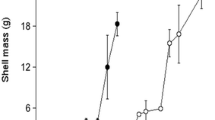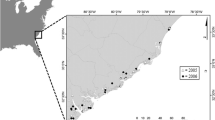Abstract
Pacific oyster spat (Crassostrea gigas Thunberg) transferred from the Tamar Estuary to two growing areas in southern Tasmania were monitored for their metal contents over one growing season (1974–1975). Oysters at Pipeclay Lagoon were grown with stick and tray culture while those at Dart Island were cultured with the longline technique. Metal content of the oysters increased with time and the trend was similar to the weight growth curves. Mean dry weights of oysters increased from 0.07 to 1.19 g at Pipeclay Lagoon and from 0.25 to 1.47 g at Dart Island. Metal contents (μg) increased at each site, respectively: Fe 57 to 326; 91 to 446; Zn 259 to 6 555; 755 to 5 335; Cd 1.5 to 13.3; 1.9 to 16.3; Cu 26 to 142; 9 to 116; Pb 1.9 to 11.9; 0.6 to 3.8. Concentration curves generally showed a downward trend with time. The relationships of metal concentrations with weight did not differ from sample to sample at a site nor did they differ at one site compared with the other. The only exception was lead, which showed no relationship of concentration with weight at Pipeclay Lagoon and a negative one at Dart Island. It is postulated that higher winter concentrations of metals in the oysters were linked with greater solubility of metal ions in lower salinity water.
Similar content being viewed by others
Literature Cited
Ayling, G. M.: Uptake of cadmium, zinc, copper, lead and chromium in the Pacific oyster, Crassostrea gigas, grown in the Tamar River, Tasmania. Wat. Res. 8, 729–738 (1974)
Boyden, C. R.: Trace element content and body size in molluscs. Nature, Lond. 251, 311–314 (1974)
Boyden, C. R.: Effect of size upon metal content of shellfish. J. mar. biol. Ass. U.K. 57, 675–714 (1977)
Cunningham, P. A. and M. R. Tripp: Accumulation and depuration of mercury in the American oyster Crassostrea virginica. Mar. Biol. 20, 14–19 (1973)
Cunningham, P. A. and M. R. Tripp: Factors affecting the accumulation and removal of mercury from tissues of the American oyster Crassostrea virginica. Mar. Biol. 31, 311–319 (1975a)
Cunningham, P. A. and M. R. Tripp: Accumulation, tissue distribution and elimination of 203HgCl2 and CH3 203HgCl in the tissues of the American oyster Crassostrea virginica. Mar. Biol. 31, 321–334 (1975b)
Galtsoff, P. S.: The American oyster Crassostrea virginica Gmelin. Fish. Bull. U.S. 64, 1–480 (1964)
Mackay, N. J., R. J. Williams, J. L. Kacprzac, M. N. Kazacos, A. J. Collins and E. H. Auty: Heavy metals in cultivated oysters (Crassostrea commercialis=Saccostrea cucullata) from the estuaries of New South Wales. Aust. J. mar. Freshwat. Res. 26, 31–46 (1975)
Malcolm, W. B.: The Sydney rock oyster. The Fisherman, winter 1972, 1–5 (1972)
National Health and Medical Research Council: Heavy metal contaminants in seafoods — cadmium and zinc, In: Report of the 77 Session 1973, Appendix XI, pp 100–109. Canberra: Australian Government Publishing Service 1974
Nelder, J. A. and Members of the Rothampstead Statistics Department: Genstat reference manual, Inter-University/Research Councils Series, Report No. 3, 3rd ed. Edinburgh: Program Library Unit, Edinburgh Regional Computing Centre 1975
Preston, A.: Concentration of 65Zn in the flesh of oysters related to the discharge of coaling power effluent from the C.E.G.B. Nuclear Power Station at Bradwell-on-Sea, Essex. In: Proceedings of the International Symposium on Radioecological Concentration Processes, Stockholm 1966, pp 995–1004. Ed. by B. Aberg and F. P. Hungate. Oxford: Pergamon Press 1966. (In Boyden, 1977)
Ratkowsky, D. A., S. J. Thrower, I. J. Eustace and J. Olley: A numerical study of the concentration of some heavy metals in Tasmanian oysters. J. Fish. Res. Bd Can. 31, 1165–1171 (1974)
Schulz-Baldes, M.: Die Miesmuschel Mytilus edulis als Indikator for die Bleikonzentration im Weserästuar und in der Deutschen Bucht. Mar. Biol. 21, 98–102 (1973)
Sumner, C. E.: Oysters and Tasmania. Tasm. Fish. Res. 6 (2), 1–15 (1972)
Sumner, C. E.: Oysters and Tasmania Part 2, Tasm. Fish. Res. 8 (2), 1–12 (1974)
Thomson, J. M.: The acclimatization and growth of the Pacific oyster (Gryphaea gigas) in Australia. Aust. J. mar. Freshwat. Res. 3, 64–73 (1952)
Thomson, J. M.: Handbook for oyster-farmers. C.S.I.R.O. Div. Fish. Circ. 3, 1–20 (1954)
Thomson, J. M.: The naturalization of the Pacific Oyster in Australia. Aust. J. mar. Freshwat. Res. 10, 144–149 (1959)
Thrower, S. J. and I. J. Eustace: Heavy metals in Tasmanian oysters in 1972. Aust. Fish. 32 (10), 7–10 (1973a)
Thrower, S. J. and I. J. Eustace: Heavy metal accumulation in oysters grown in Tasmanian waters. Fd Technol. Aust. 25, 546–553 (1973b)
Wisely, B.: Developments in oyster culture. Aust. Fish. 35 (12), 6–7 (1976)
Author information
Authors and Affiliations
Additional information
Communicated by G. F. Humphrey, Sydney
Rights and permissions
About this article
Cite this article
Thomson, J.D. Metal concentration changes in growing Pacific oysters, Crassostrea gigas, cultivated in Tasmania, Australia. Marine Biology 67, 135–142 (1982). https://doi.org/10.1007/BF00401279
Accepted:
Issue Date:
DOI: https://doi.org/10.1007/BF00401279




